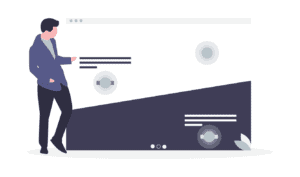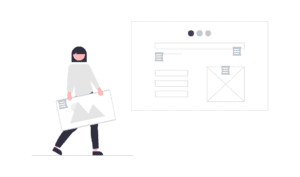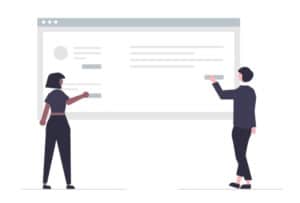Website Design
7 High Converting B2B Website Design Examples

Whether you run a SAAS platform or another type of B2B business, a website is essential for your continued success. Most purchase decisions these days begin online, with many prospects turning to search engines to find solutions to their problems.
Without a high-converting website, you could be missing opportunities to win new business. Use this guide to learn more about B2B sites, along with top B2B website design tips that can put you light years ahead of your competitors.
Quick Links
What Is a B2B Website?
Before defining what a B2B website is, let’s discuss what a B2B brand is.
It’s common for people to restrict B2B brands to SAAS companies. However, this is far from the truth. B2B companies also include the more complex industrial brands that build personal relationships with prospects and cannot convert high-dollar accounts via a checkout process.
In simple terms, a business-to-business (B2B) website speaks to business professionals. Since B2B companies have other businesses as clients, their websites need to target multiple decision-makers at different levels in a company.
What Is the Difference Between B2B and B2C Web Design?
B2B and B2C companies focus on different types of clients, which affects the presentation of the core messaging on their websites. For instance, the sales funnel and lifecycle of a B2C purchase are typically shorter than that of a B2B brand. B2C sales also tend to be emotionally-based, unlike what’s obtainable in a B2B purchasing cycle.
The type of website that fits a B2C brand will generally fall short of the requirements for a B2B company. This means you can’t paste a B2C website template on your B2B brand and expect it to work.
Four Key Elements of a High Converting B2B Web Design
A high converting website is one of the ingredients for achieving stellar success for your B2B brand. Your website should serve as a well-oiled machine for your overall B2B marketing strategy. It should take prospects from making simple inquiries to taking some action, whether they are requesting an estimate, subscribing to your service, or downloading an ebook.
Your B2B site should also focus on converting the user with well-placed CTAs (calls to action). This starts with defining your most desired conversion goal by answering the question, “what do I want my prospects to do?”
You can make a big ask like requesting completion of an intake form or the purchase of a paid subscription. If the main ask is too big, supplement it with a lesser commitment to get the user’s foot in the door. For example, you can ask prospects to schedule a call, try a free subscription, download a whitepaper, or subscribe to your newsletter.
Let’s go over other vital elements of the best B2B website designs.
1. The B2B Website Focuses On the Buyer Persona
The most important question you should ask before creating a B2B website is, “who is my target audience?” The only way to answer this question is by mapping out your buyer persona.
Typically, buyer personas vary from one business to the other. This means that you need to do in-depth research on the characteristics and preferences of your ideal customer to come up with a well-rounded description. Remember, the ultimate goal is to guide your ideal customer to the point where they recognize your business as the most effective solution to their pain points.
2. The B2B Website Is SEO-friendly
If you want your website to show up in search results and get found easily, you must ensure it is SEO-friendly. More than having relevant keywords and tags on your site, you should pay attention to other SEO best practices, such as satisfying technical search engine optimization requirements.
3. The B2B Website Is Easy to Navigate
Your website isn’t a maze, so it shouldn’t look or feel like one. Consumers should find it easy to navigate from one point to the other and find information quickly. The more you allow your prospects to virtually experience and interact with your offers, the higher your conversion rates.
In addition, the B2B website should be responsive, with the different pages loading rapidly. Slow page load time affects the site’s overall user experience and sends your bounce rate through the roof. Very few things come close to the frustration a customer experiences when a website takes forever to load one page.
4. An Effective B2B Website Has Plenty of Social Proof
Word of mouth is one of the most powerful conversion tools in the B2B universe. Prospective customers love reading case studies, blog posts, and other social proof content that show how you have helped similar businesses achieve their goals.
How do you include social proof on your business website? To start, list several customer reviews on your website. You can also dedicate a page to case studies and testimonials for visitors to read through.
Seven Great B2B Website Design Examples
Source: Undraw
Let’s look at seven real-life examples of the best B2B websites.
Asana
Asana places several effective CTAs at strategic points on the website. There’s a bold call to action on the home page, prompting visitors to try the product for free. It also uses engaging animations and interactive elements to nudge visitors to learn more about the product and navigate related pages.
Zoom
Zoom’s website is set to convert visitors from the get-go. The headings and copy are compelling and concise, and the call to action prompts B2B buyers to sign up for a Zoom account right away. Everything you need to know about their product is also shown on the home page.
Moo
The overall look and feel of Moo’s website is trendy and fun, which demonstrates how potential customers perceive the product. They use perfectly curated visual designs to captivate visitors and draw attention to their services and core offerings.
Symbia Logistics
Getting visitors to complete an intake form is the primary goal of Symbia Logistics’ website. Symbia uses a few different phrases for their CTA buttons, all of which direct the user to Request a Quote. By switching out CTA verbiage across the buttons, the buttons feel less repetitive and the requested action appeals to a broader audience.
Even though your ideal customers are other businesses, remember that the key decision-makers in these companies are people too…
Freightliner
The first thing you’ll notice on the freightliner website is its exciting and colorful user interface. It has a bold headline that communicates the unique value of the product. The CTAs are simple but compelling, and they follow the tone already established in the headline. For example, just below the subtext, you’d find clear CTAs that prompt visitors to explore the major trucks available.
Kiewit
Although this website isn’t stacked with traditional lead-generation CTAs, it captures the visitor’s interest by showcasing the credibility and expertise of the brand. From well-qualified employees to awards and recognitions, Kiewit leaves no stone unturned in communicating the strength of its brand. In this example, the established brand does the heavy-lifting and converting new business is all about picking up the phone.
XPO Logistics
Apart from its highly-interactive design, the XPO Logistics website has clear and precise copy that gives visitors a good idea of the services they offer. The simple “learn more” CTA placed at strategic points of the homepage allows visitors to explore the website a little bit at a time, without being overwhelmed.
Summary
Your website is an integral part of your content marketing strategy, and it can make or break your brand, so you have to get it right. Even though your ideal customers are other businesses, remember that the key decision-makers in these companies are people too, so your website should appeal to their human sensibilities.
By creating an effective B2B website, you can attract more customers like the ones you already adore. If you need help with B2B website design, schedule a call with the pros at HyFyve, and we’ll guide you to the next level.





